Report on Security and Risk Management for Unilever (BUS 123)
VerifiedAdded on 2020/06/03
|13
|3686
|105
Report
AI Summary
This report provides a comprehensive analysis of risk management within Unilever, a multinational consumer goods company. It begins by defining risk and its various aspects in a business context, emphasizing the need for a proper understanding of potential threats. The report then focuses on the role of a security manager in controlling these risks, particularly in the context of Unilever's operations. It identifies and discusses several key risk categories, including strategic risk, financial risk, environmental risk, operational risk, compliance risk, and reputational risk. Each risk type is thoroughly explained, detailing potential causes, impacts, and specific examples relevant to Unilever's business model. Furthermore, the report explores additional risks such as customer loss and employee turnover, highlighting their potential consequences. Overall, the report aims to provide insights into the complex risk landscape of Unilever and the importance of effective risk management strategies.
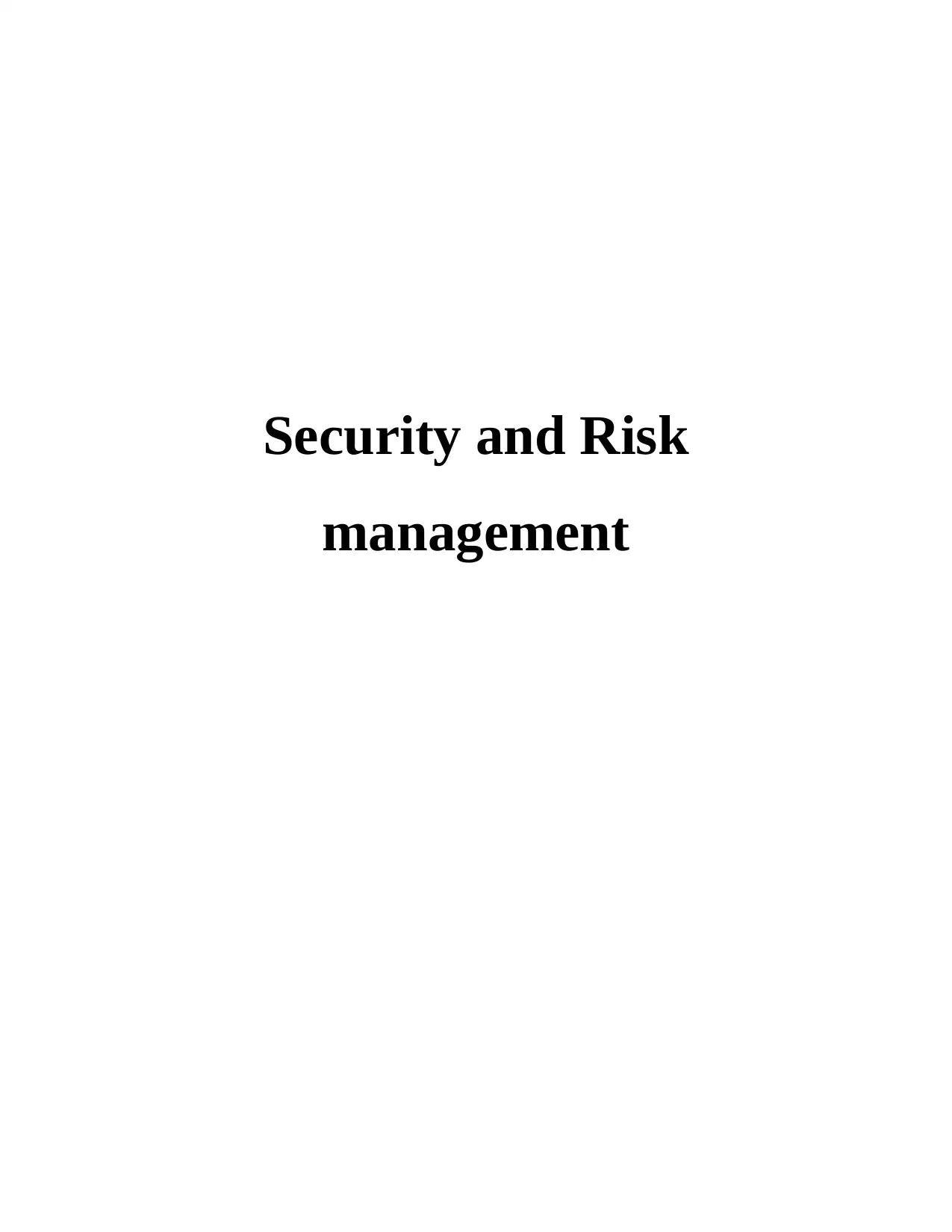
Security and Risk
management
management
Paraphrase This Document
Need a fresh take? Get an instant paraphrase of this document with our AI Paraphraser
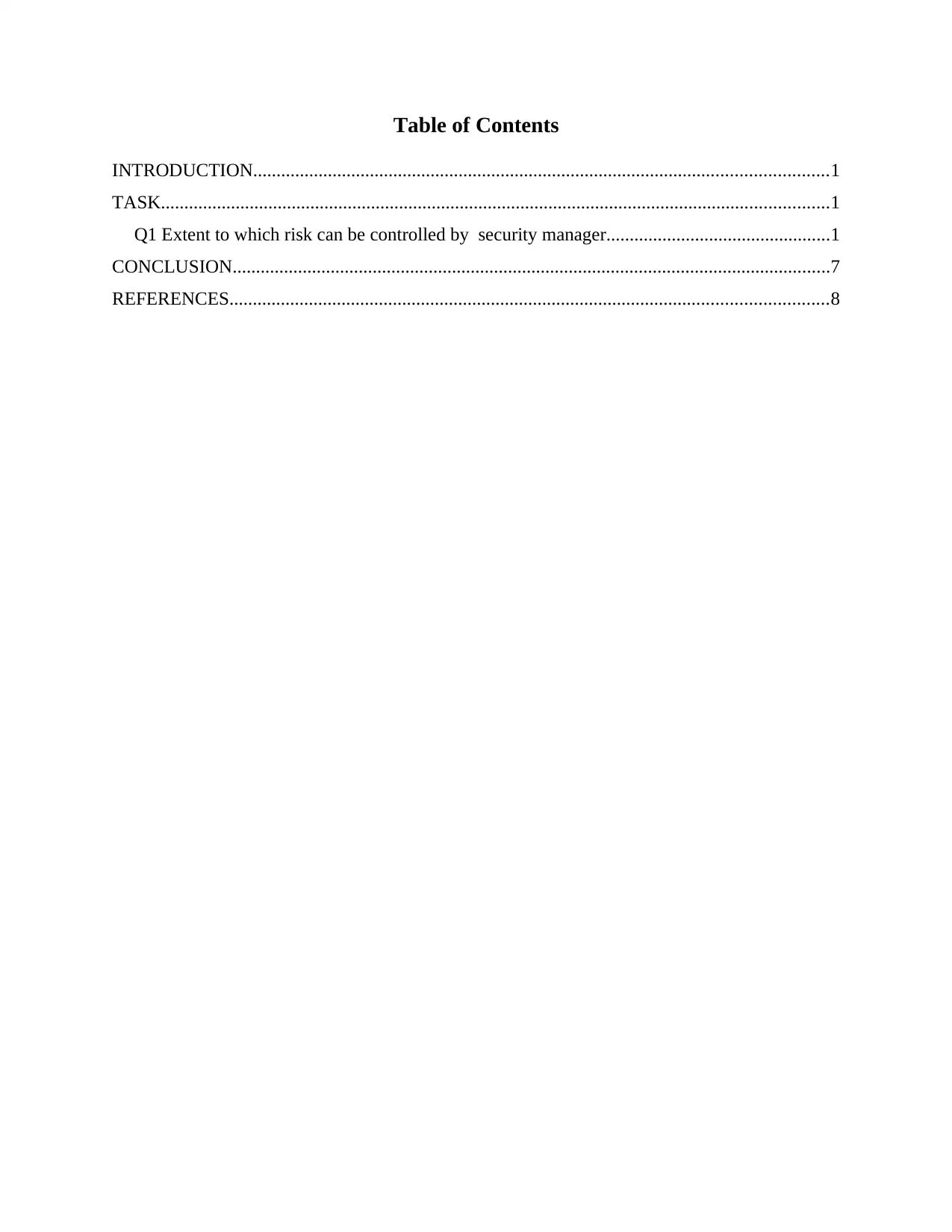
Table of Contents
INTRODUCTION...........................................................................................................................1
TASK...............................................................................................................................................1
Q1 Extent to which risk can be controlled by security manager................................................1
CONCLUSION................................................................................................................................7
REFERENCES................................................................................................................................8
INTRODUCTION...........................................................................................................................1
TASK...............................................................................................................................................1
Q1 Extent to which risk can be controlled by security manager................................................1
CONCLUSION................................................................................................................................7
REFERENCES................................................................................................................................8
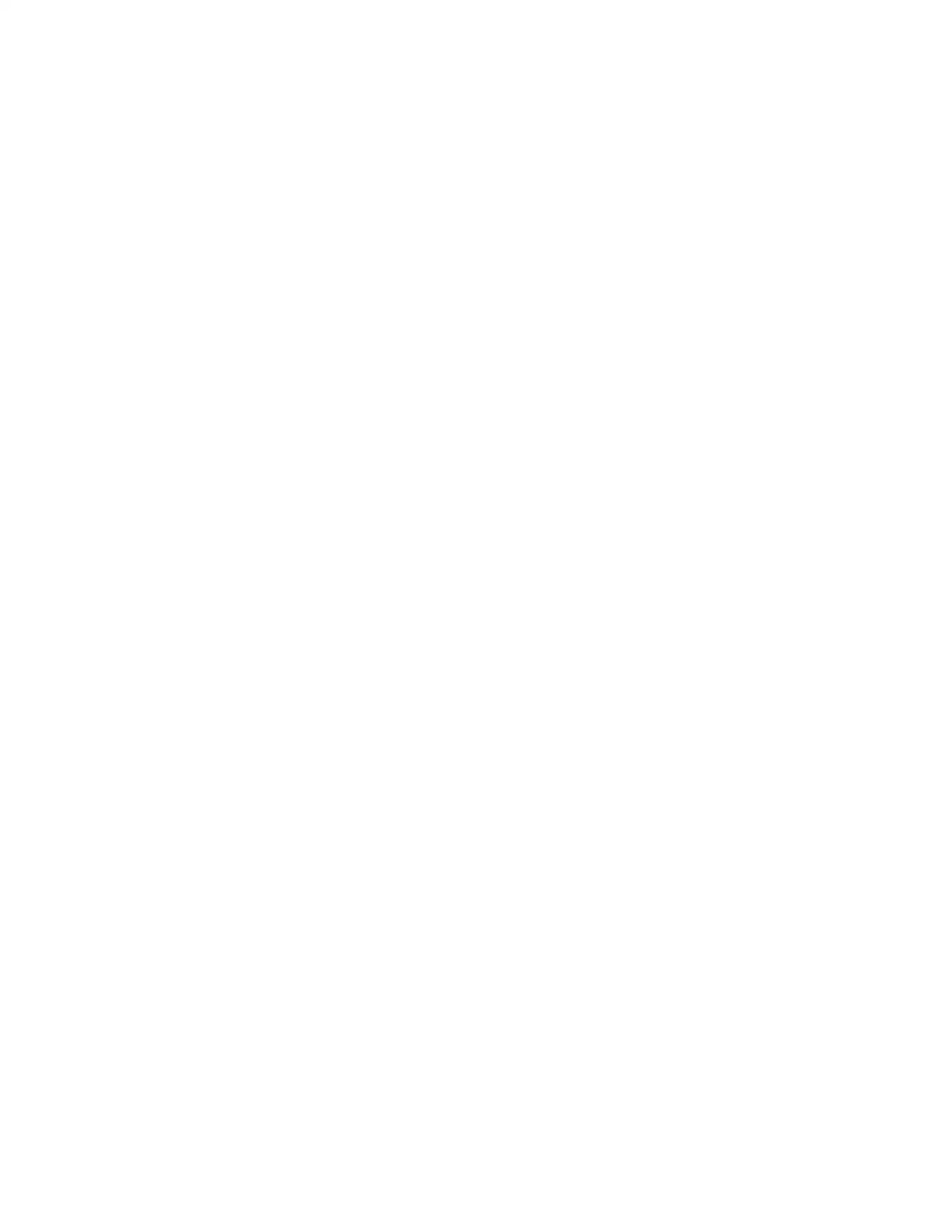
⊘ This is a preview!⊘
Do you want full access?
Subscribe today to unlock all pages.

Trusted by 1+ million students worldwide
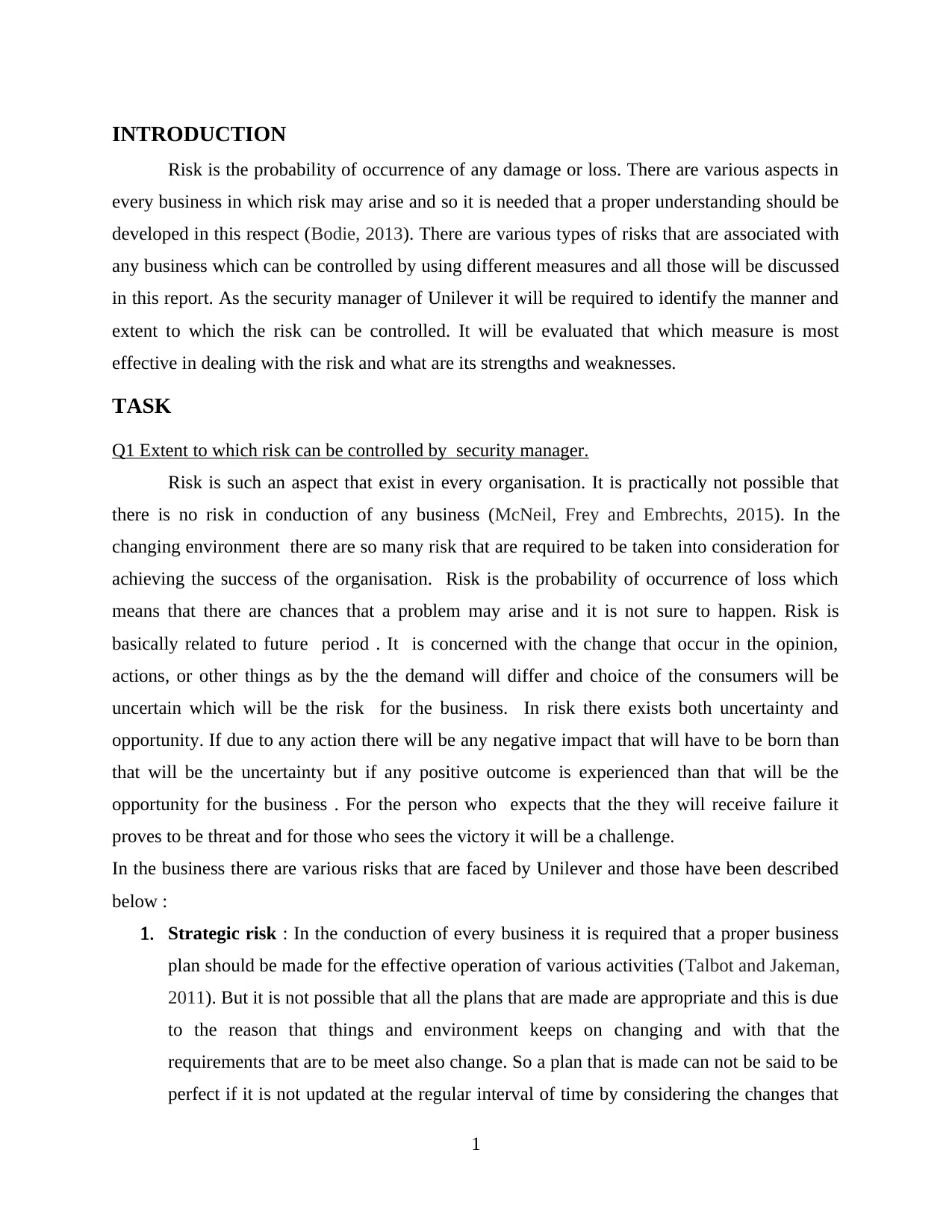
INTRODUCTION
Risk is the probability of occurrence of any damage or loss. There are various aspects in
every business in which risk may arise and so it is needed that a proper understanding should be
developed in this respect (Bodie, 2013). There are various types of risks that are associated with
any business which can be controlled by using different measures and all those will be discussed
in this report. As the security manager of Unilever it will be required to identify the manner and
extent to which the risk can be controlled. It will be evaluated that which measure is most
effective in dealing with the risk and what are its strengths and weaknesses.
TASK
Q1 Extent to which risk can be controlled by security manager.
Risk is such an aspect that exist in every organisation. It is practically not possible that
there is no risk in conduction of any business (McNeil, Frey and Embrechts, 2015). In the
changing environment there are so many risk that are required to be taken into consideration for
achieving the success of the organisation. Risk is the probability of occurrence of loss which
means that there are chances that a problem may arise and it is not sure to happen. Risk is
basically related to future period . It is concerned with the change that occur in the opinion,
actions, or other things as by the the demand will differ and choice of the consumers will be
uncertain which will be the risk for the business. In risk there exists both uncertainty and
opportunity. If due to any action there will be any negative impact that will have to be born than
that will be the uncertainty but if any positive outcome is experienced than that will be the
opportunity for the business . For the person who expects that the they will receive failure it
proves to be threat and for those who sees the victory it will be a challenge.
In the business there are various risks that are faced by Unilever and those have been described
below :
1. Strategic risk : In the conduction of every business it is required that a proper business
plan should be made for the effective operation of various activities (Talbot and Jakeman,
2011). But it is not possible that all the plans that are made are appropriate and this is due
to the reason that things and environment keeps on changing and with that the
requirements that are to be meet also change. So a plan that is made can not be said to be
perfect if it is not updated at the regular interval of time by considering the changes that
1
Risk is the probability of occurrence of any damage or loss. There are various aspects in
every business in which risk may arise and so it is needed that a proper understanding should be
developed in this respect (Bodie, 2013). There are various types of risks that are associated with
any business which can be controlled by using different measures and all those will be discussed
in this report. As the security manager of Unilever it will be required to identify the manner and
extent to which the risk can be controlled. It will be evaluated that which measure is most
effective in dealing with the risk and what are its strengths and weaknesses.
TASK
Q1 Extent to which risk can be controlled by security manager.
Risk is such an aspect that exist in every organisation. It is practically not possible that
there is no risk in conduction of any business (McNeil, Frey and Embrechts, 2015). In the
changing environment there are so many risk that are required to be taken into consideration for
achieving the success of the organisation. Risk is the probability of occurrence of loss which
means that there are chances that a problem may arise and it is not sure to happen. Risk is
basically related to future period . It is concerned with the change that occur in the opinion,
actions, or other things as by the the demand will differ and choice of the consumers will be
uncertain which will be the risk for the business. In risk there exists both uncertainty and
opportunity. If due to any action there will be any negative impact that will have to be born than
that will be the uncertainty but if any positive outcome is experienced than that will be the
opportunity for the business . For the person who expects that the they will receive failure it
proves to be threat and for those who sees the victory it will be a challenge.
In the business there are various risks that are faced by Unilever and those have been described
below :
1. Strategic risk : In the conduction of every business it is required that a proper business
plan should be made for the effective operation of various activities (Talbot and Jakeman,
2011). But it is not possible that all the plans that are made are appropriate and this is due
to the reason that things and environment keeps on changing and with that the
requirements that are to be meet also change. So a plan that is made can not be said to be
perfect if it is not updated at the regular interval of time by considering the changes that
1
Paraphrase This Document
Need a fresh take? Get an instant paraphrase of this document with our AI Paraphraser
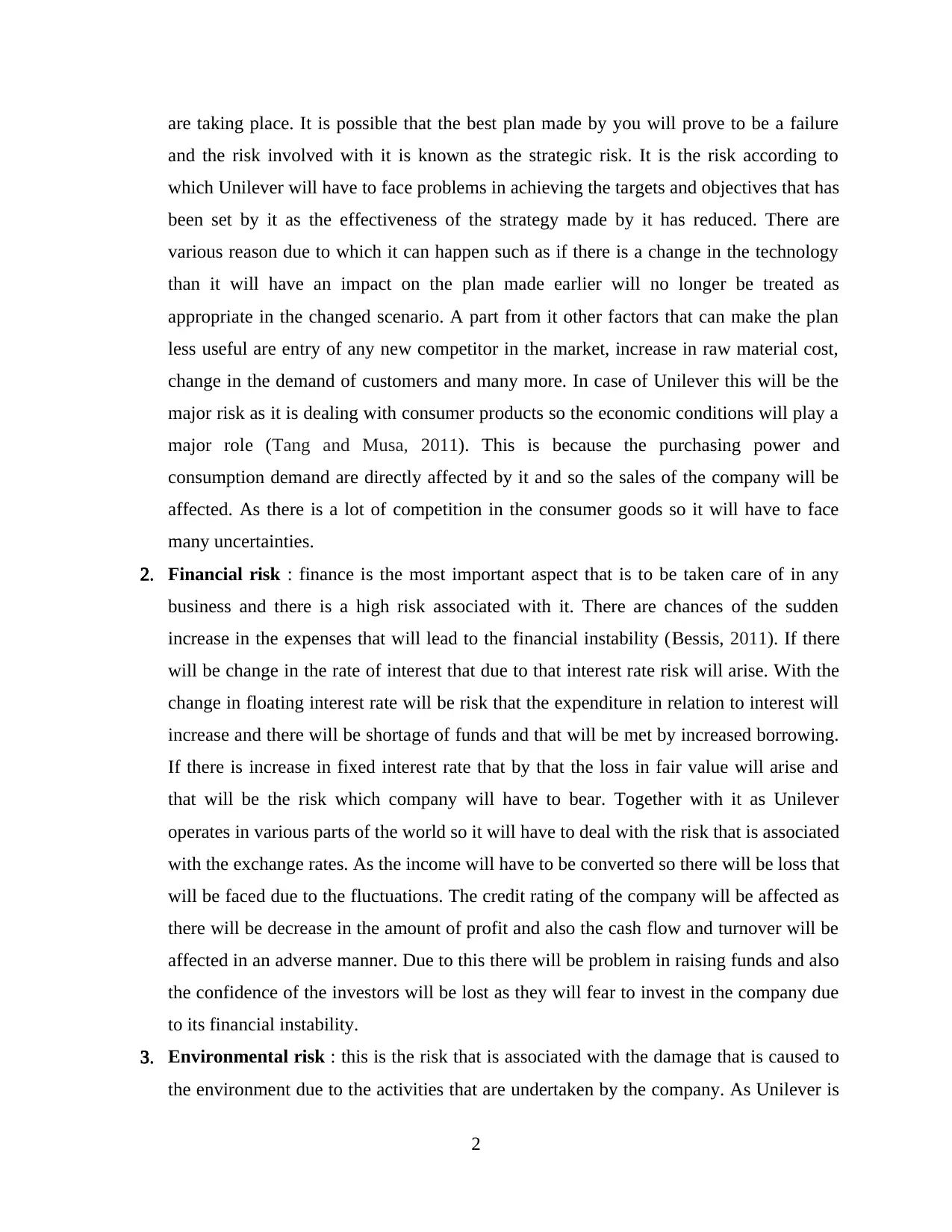
are taking place. It is possible that the best plan made by you will prove to be a failure
and the risk involved with it is known as the strategic risk. It is the risk according to
which Unilever will have to face problems in achieving the targets and objectives that has
been set by it as the effectiveness of the strategy made by it has reduced. There are
various reason due to which it can happen such as if there is a change in the technology
than it will have an impact on the plan made earlier will no longer be treated as
appropriate in the changed scenario. A part from it other factors that can make the plan
less useful are entry of any new competitor in the market, increase in raw material cost,
change in the demand of customers and many more. In case of Unilever this will be the
major risk as it is dealing with consumer products so the economic conditions will play a
major role (Tang and Musa, 2011). This is because the purchasing power and
consumption demand are directly affected by it and so the sales of the company will be
affected. As there is a lot of competition in the consumer goods so it will have to face
many uncertainties.
2. Financial risk : finance is the most important aspect that is to be taken care of in any
business and there is a high risk associated with it. There are chances of the sudden
increase in the expenses that will lead to the financial instability (Bessis, 2011). If there
will be change in the rate of interest that due to that interest rate risk will arise. With the
change in floating interest rate will be risk that the expenditure in relation to interest will
increase and there will be shortage of funds and that will be met by increased borrowing.
If there is increase in fixed interest rate that by that the loss in fair value will arise and
that will be the risk which company will have to bear. Together with it as Unilever
operates in various parts of the world so it will have to deal with the risk that is associated
with the exchange rates. As the income will have to be converted so there will be loss that
will be faced due to the fluctuations. The credit rating of the company will be affected as
there will be decrease in the amount of profit and also the cash flow and turnover will be
affected in an adverse manner. Due to this there will be problem in raising funds and also
the confidence of the investors will be lost as they will fear to invest in the company due
to its financial instability.
3. Environmental risk : this is the risk that is associated with the damage that is caused to
the environment due to the activities that are undertaken by the company. As Unilever is
2
and the risk involved with it is known as the strategic risk. It is the risk according to
which Unilever will have to face problems in achieving the targets and objectives that has
been set by it as the effectiveness of the strategy made by it has reduced. There are
various reason due to which it can happen such as if there is a change in the technology
than it will have an impact on the plan made earlier will no longer be treated as
appropriate in the changed scenario. A part from it other factors that can make the plan
less useful are entry of any new competitor in the market, increase in raw material cost,
change in the demand of customers and many more. In case of Unilever this will be the
major risk as it is dealing with consumer products so the economic conditions will play a
major role (Tang and Musa, 2011). This is because the purchasing power and
consumption demand are directly affected by it and so the sales of the company will be
affected. As there is a lot of competition in the consumer goods so it will have to face
many uncertainties.
2. Financial risk : finance is the most important aspect that is to be taken care of in any
business and there is a high risk associated with it. There are chances of the sudden
increase in the expenses that will lead to the financial instability (Bessis, 2011). If there
will be change in the rate of interest that due to that interest rate risk will arise. With the
change in floating interest rate will be risk that the expenditure in relation to interest will
increase and there will be shortage of funds and that will be met by increased borrowing.
If there is increase in fixed interest rate that by that the loss in fair value will arise and
that will be the risk which company will have to bear. Together with it as Unilever
operates in various parts of the world so it will have to deal with the risk that is associated
with the exchange rates. As the income will have to be converted so there will be loss that
will be faced due to the fluctuations. The credit rating of the company will be affected as
there will be decrease in the amount of profit and also the cash flow and turnover will be
affected in an adverse manner. Due to this there will be problem in raising funds and also
the confidence of the investors will be lost as they will fear to invest in the company due
to its financial instability.
3. Environmental risk : this is the risk that is associated with the damage that is caused to
the environment due to the activities that are undertaken by the company. As Unilever is
2
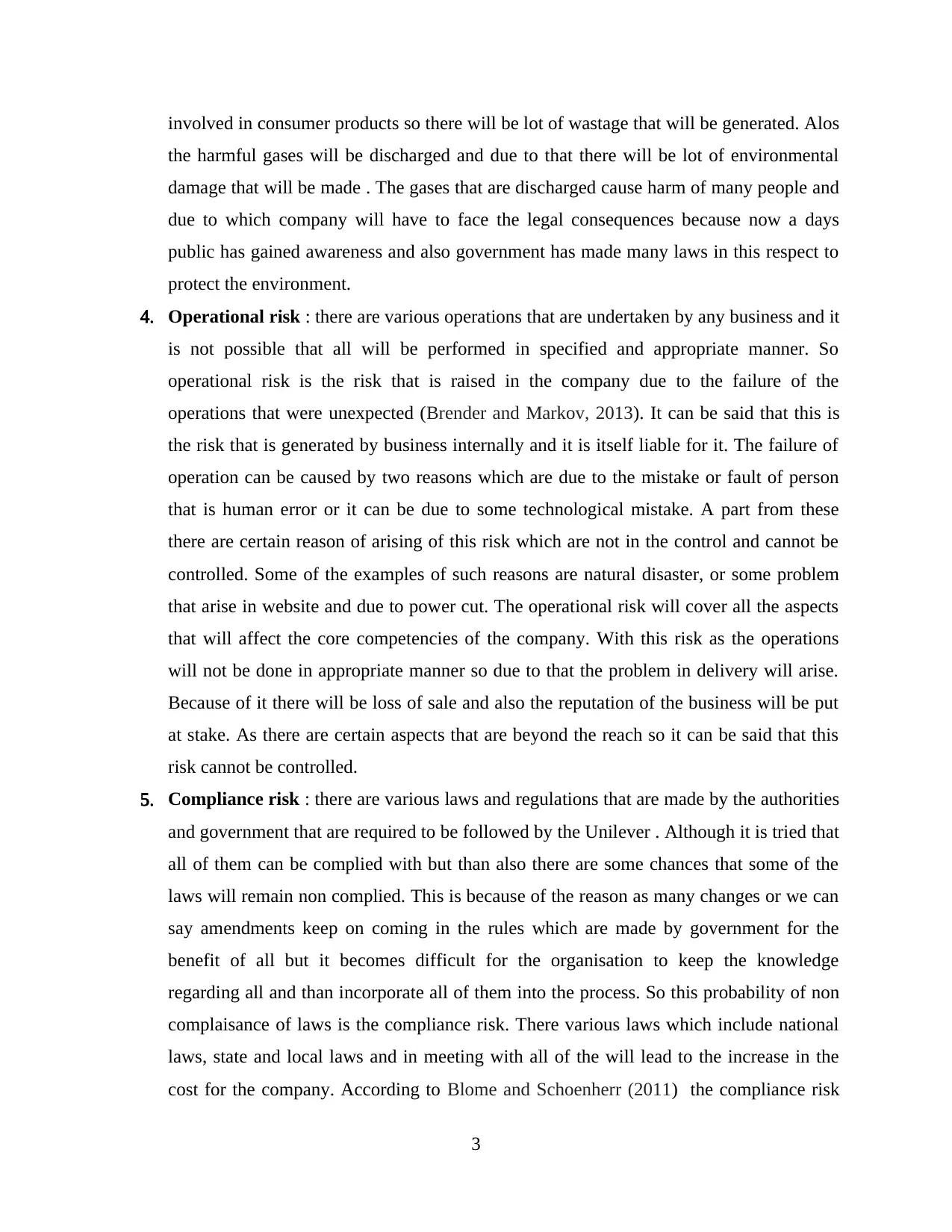
involved in consumer products so there will be lot of wastage that will be generated. Alos
the harmful gases will be discharged and due to that there will be lot of environmental
damage that will be made . The gases that are discharged cause harm of many people and
due to which company will have to face the legal consequences because now a days
public has gained awareness and also government has made many laws in this respect to
protect the environment.
4. Operational risk : there are various operations that are undertaken by any business and it
is not possible that all will be performed in specified and appropriate manner. So
operational risk is the risk that is raised in the company due to the failure of the
operations that were unexpected (Brender and Markov, 2013). It can be said that this is
the risk that is generated by business internally and it is itself liable for it. The failure of
operation can be caused by two reasons which are due to the mistake or fault of person
that is human error or it can be due to some technological mistake. A part from these
there are certain reason of arising of this risk which are not in the control and cannot be
controlled. Some of the examples of such reasons are natural disaster, or some problem
that arise in website and due to power cut. The operational risk will cover all the aspects
that will affect the core competencies of the company. With this risk as the operations
will not be done in appropriate manner so due to that the problem in delivery will arise.
Because of it there will be loss of sale and also the reputation of the business will be put
at stake. As there are certain aspects that are beyond the reach so it can be said that this
risk cannot be controlled.
5. Compliance risk : there are various laws and regulations that are made by the authorities
and government that are required to be followed by the Unilever . Although it is tried that
all of them can be complied with but than also there are some chances that some of the
laws will remain non complied. This is because of the reason as many changes or we can
say amendments keep on coming in the rules which are made by government for the
benefit of all but it becomes difficult for the organisation to keep the knowledge
regarding all and than incorporate all of them into the process. So this probability of non
complaisance of laws is the compliance risk. There various laws which include national
laws, state and local laws and in meeting with all of the will lead to the increase in the
cost for the company. According to Blome and Schoenherr (2011) the compliance risk
3
the harmful gases will be discharged and due to that there will be lot of environmental
damage that will be made . The gases that are discharged cause harm of many people and
due to which company will have to face the legal consequences because now a days
public has gained awareness and also government has made many laws in this respect to
protect the environment.
4. Operational risk : there are various operations that are undertaken by any business and it
is not possible that all will be performed in specified and appropriate manner. So
operational risk is the risk that is raised in the company due to the failure of the
operations that were unexpected (Brender and Markov, 2013). It can be said that this is
the risk that is generated by business internally and it is itself liable for it. The failure of
operation can be caused by two reasons which are due to the mistake or fault of person
that is human error or it can be due to some technological mistake. A part from these
there are certain reason of arising of this risk which are not in the control and cannot be
controlled. Some of the examples of such reasons are natural disaster, or some problem
that arise in website and due to power cut. The operational risk will cover all the aspects
that will affect the core competencies of the company. With this risk as the operations
will not be done in appropriate manner so due to that the problem in delivery will arise.
Because of it there will be loss of sale and also the reputation of the business will be put
at stake. As there are certain aspects that are beyond the reach so it can be said that this
risk cannot be controlled.
5. Compliance risk : there are various laws and regulations that are made by the authorities
and government that are required to be followed by the Unilever . Although it is tried that
all of them can be complied with but than also there are some chances that some of the
laws will remain non complied. This is because of the reason as many changes or we can
say amendments keep on coming in the rules which are made by government for the
benefit of all but it becomes difficult for the organisation to keep the knowledge
regarding all and than incorporate all of them into the process. So this probability of non
complaisance of laws is the compliance risk. There various laws which include national
laws, state and local laws and in meeting with all of the will lead to the increase in the
cost for the company. According to Blome and Schoenherr (2011) the compliance risk
3
⊘ This is a preview!⊘
Do you want full access?
Subscribe today to unlock all pages.

Trusted by 1+ million students worldwide
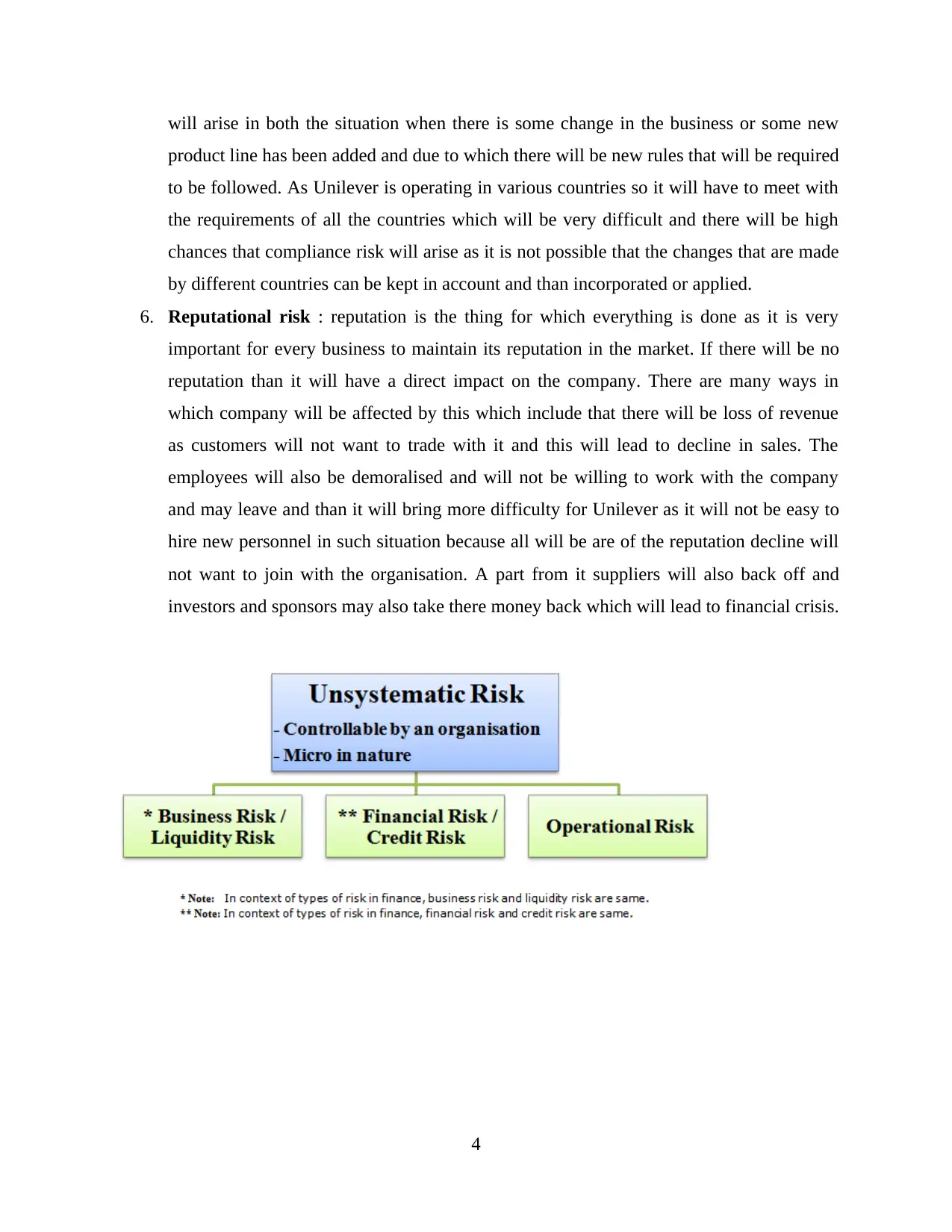
will arise in both the situation when there is some change in the business or some new
product line has been added and due to which there will be new rules that will be required
to be followed. As Unilever is operating in various countries so it will have to meet with
the requirements of all the countries which will be very difficult and there will be high
chances that compliance risk will arise as it is not possible that the changes that are made
by different countries can be kept in account and than incorporated or applied.
6. Reputational risk : reputation is the thing for which everything is done as it is very
important for every business to maintain its reputation in the market. If there will be no
reputation than it will have a direct impact on the company. There are many ways in
which company will be affected by this which include that there will be loss of revenue
as customers will not want to trade with it and this will lead to decline in sales. The
employees will also be demoralised and will not be willing to work with the company
and may leave and than it will bring more difficulty for Unilever as it will not be easy to
hire new personnel in such situation because all will be are of the reputation decline will
not want to join with the organisation. A part from it suppliers will also back off and
investors and sponsors may also take there money back which will lead to financial crisis.
4
product line has been added and due to which there will be new rules that will be required
to be followed. As Unilever is operating in various countries so it will have to meet with
the requirements of all the countries which will be very difficult and there will be high
chances that compliance risk will arise as it is not possible that the changes that are made
by different countries can be kept in account and than incorporated or applied.
6. Reputational risk : reputation is the thing for which everything is done as it is very
important for every business to maintain its reputation in the market. If there will be no
reputation than it will have a direct impact on the company. There are many ways in
which company will be affected by this which include that there will be loss of revenue
as customers will not want to trade with it and this will lead to decline in sales. The
employees will also be demoralised and will not be willing to work with the company
and may leave and than it will bring more difficulty for Unilever as it will not be easy to
hire new personnel in such situation because all will be are of the reputation decline will
not want to join with the organisation. A part from it suppliers will also back off and
investors and sponsors may also take there money back which will lead to financial crisis.
4
Paraphrase This Document
Need a fresh take? Get an instant paraphrase of this document with our AI Paraphraser
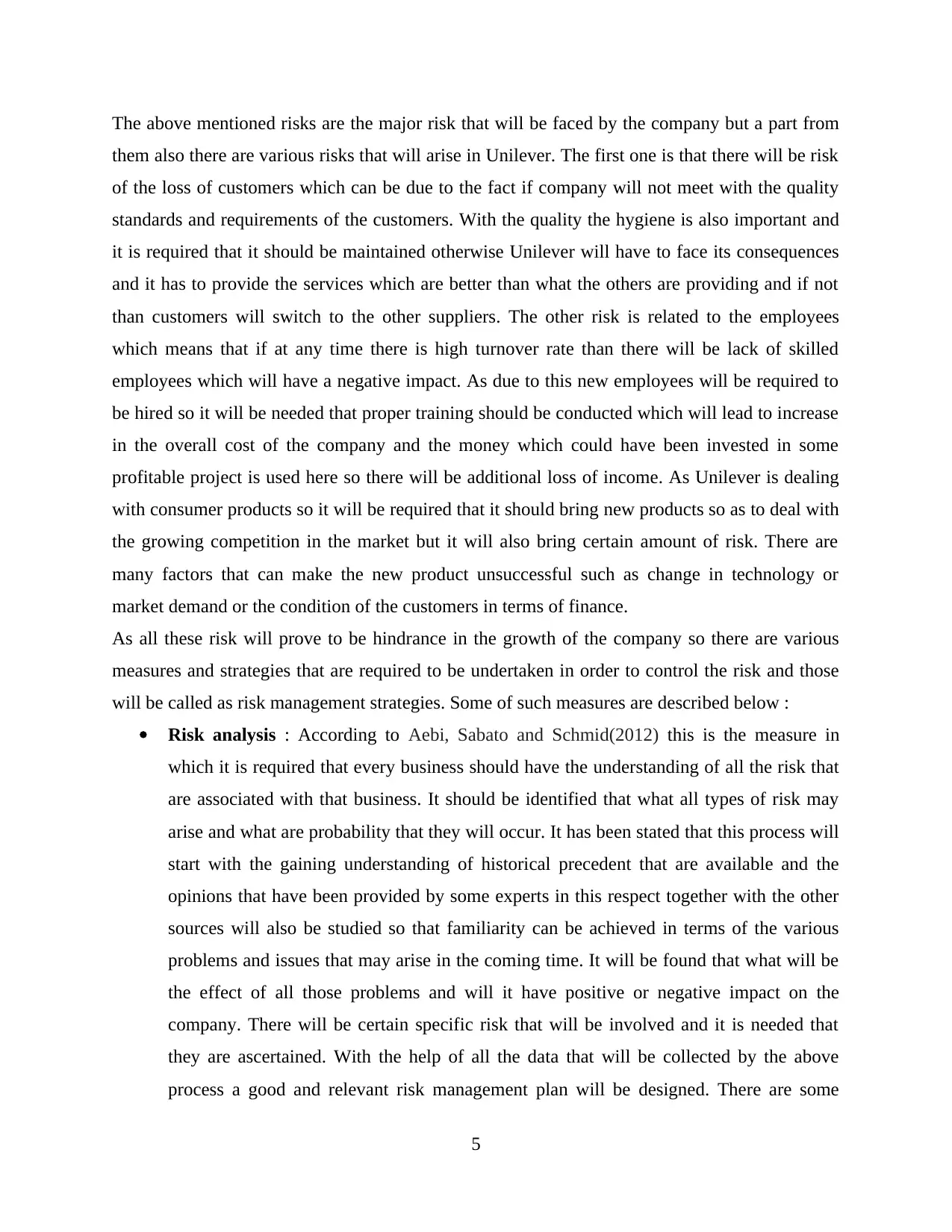
The above mentioned risks are the major risk that will be faced by the company but a part from
them also there are various risks that will arise in Unilever. The first one is that there will be risk
of the loss of customers which can be due to the fact if company will not meet with the quality
standards and requirements of the customers. With the quality the hygiene is also important and
it is required that it should be maintained otherwise Unilever will have to face its consequences
and it has to provide the services which are better than what the others are providing and if not
than customers will switch to the other suppliers. The other risk is related to the employees
which means that if at any time there is high turnover rate than there will be lack of skilled
employees which will have a negative impact. As due to this new employees will be required to
be hired so it will be needed that proper training should be conducted which will lead to increase
in the overall cost of the company and the money which could have been invested in some
profitable project is used here so there will be additional loss of income. As Unilever is dealing
with consumer products so it will be required that it should bring new products so as to deal with
the growing competition in the market but it will also bring certain amount of risk. There are
many factors that can make the new product unsuccessful such as change in technology or
market demand or the condition of the customers in terms of finance.
As all these risk will prove to be hindrance in the growth of the company so there are various
measures and strategies that are required to be undertaken in order to control the risk and those
will be called as risk management strategies. Some of such measures are described below :
Risk analysis : According to Aebi, Sabato and Schmid(2012) this is the measure in
which it is required that every business should have the understanding of all the risk that
are associated with that business. It should be identified that what all types of risk may
arise and what are probability that they will occur. It has been stated that this process will
start with the gaining understanding of historical precedent that are available and the
opinions that have been provided by some experts in this respect together with the other
sources will also be studied so that familiarity can be achieved in terms of the various
problems and issues that may arise in the coming time. It will be found that what will be
the effect of all those problems and will it have positive or negative impact on the
company. There will be certain specific risk that will be involved and it is needed that
they are ascertained. With the help of all the data that will be collected by the above
process a good and relevant risk management plan will be designed. There are some
5
them also there are various risks that will arise in Unilever. The first one is that there will be risk
of the loss of customers which can be due to the fact if company will not meet with the quality
standards and requirements of the customers. With the quality the hygiene is also important and
it is required that it should be maintained otherwise Unilever will have to face its consequences
and it has to provide the services which are better than what the others are providing and if not
than customers will switch to the other suppliers. The other risk is related to the employees
which means that if at any time there is high turnover rate than there will be lack of skilled
employees which will have a negative impact. As due to this new employees will be required to
be hired so it will be needed that proper training should be conducted which will lead to increase
in the overall cost of the company and the money which could have been invested in some
profitable project is used here so there will be additional loss of income. As Unilever is dealing
with consumer products so it will be required that it should bring new products so as to deal with
the growing competition in the market but it will also bring certain amount of risk. There are
many factors that can make the new product unsuccessful such as change in technology or
market demand or the condition of the customers in terms of finance.
As all these risk will prove to be hindrance in the growth of the company so there are various
measures and strategies that are required to be undertaken in order to control the risk and those
will be called as risk management strategies. Some of such measures are described below :
Risk analysis : According to Aebi, Sabato and Schmid(2012) this is the measure in
which it is required that every business should have the understanding of all the risk that
are associated with that business. It should be identified that what all types of risk may
arise and what are probability that they will occur. It has been stated that this process will
start with the gaining understanding of historical precedent that are available and the
opinions that have been provided by some experts in this respect together with the other
sources will also be studied so that familiarity can be achieved in terms of the various
problems and issues that may arise in the coming time. It will be found that what will be
the effect of all those problems and will it have positive or negative impact on the
company. There will be certain specific risk that will be involved and it is needed that
they are ascertained. With the help of all the data that will be collected by the above
process a good and relevant risk management plan will be designed. There are some
5
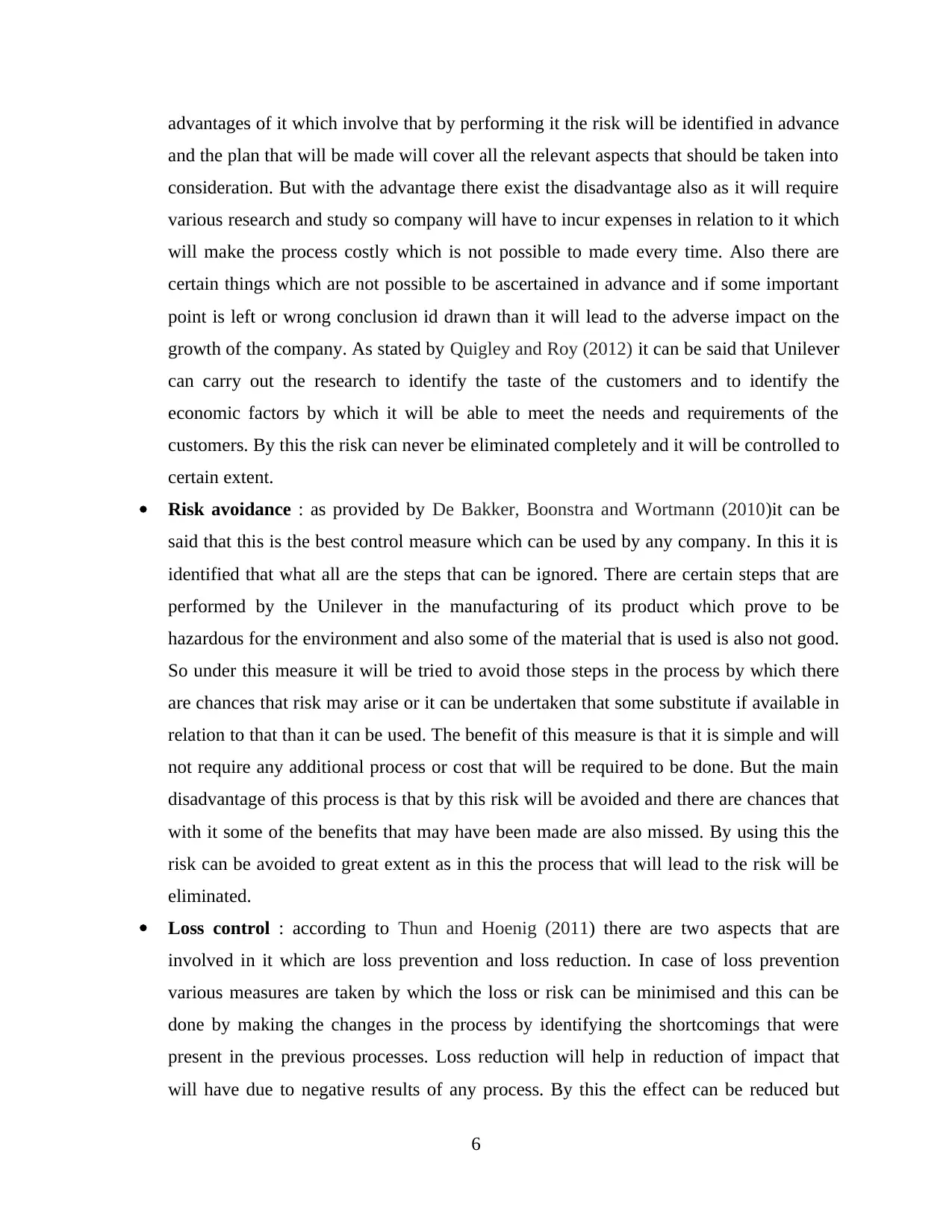
advantages of it which involve that by performing it the risk will be identified in advance
and the plan that will be made will cover all the relevant aspects that should be taken into
consideration. But with the advantage there exist the disadvantage also as it will require
various research and study so company will have to incur expenses in relation to it which
will make the process costly which is not possible to made every time. Also there are
certain things which are not possible to be ascertained in advance and if some important
point is left or wrong conclusion id drawn than it will lead to the adverse impact on the
growth of the company. As stated by Quigley and Roy (2012) it can be said that Unilever
can carry out the research to identify the taste of the customers and to identify the
economic factors by which it will be able to meet the needs and requirements of the
customers. By this the risk can never be eliminated completely and it will be controlled to
certain extent.
Risk avoidance : as provided by De Bakker, Boonstra and Wortmann (2010)it can be
said that this is the best control measure which can be used by any company. In this it is
identified that what all are the steps that can be ignored. There are certain steps that are
performed by the Unilever in the manufacturing of its product which prove to be
hazardous for the environment and also some of the material that is used is also not good.
So under this measure it will be tried to avoid those steps in the process by which there
are chances that risk may arise or it can be undertaken that some substitute if available in
relation to that than it can be used. The benefit of this measure is that it is simple and will
not require any additional process or cost that will be required to be done. But the main
disadvantage of this process is that by this risk will be avoided and there are chances that
with it some of the benefits that may have been made are also missed. By using this the
risk can be avoided to great extent as in this the process that will lead to the risk will be
eliminated.
Loss control : according to Thun and Hoenig (2011) there are two aspects that are
involved in it which are loss prevention and loss reduction. In case of loss prevention
various measures are taken by which the loss or risk can be minimised and this can be
done by making the changes in the process by identifying the shortcomings that were
present in the previous processes. Loss reduction will help in reduction of impact that
will have due to negative results of any process. By this the effect can be reduced but
6
and the plan that will be made will cover all the relevant aspects that should be taken into
consideration. But with the advantage there exist the disadvantage also as it will require
various research and study so company will have to incur expenses in relation to it which
will make the process costly which is not possible to made every time. Also there are
certain things which are not possible to be ascertained in advance and if some important
point is left or wrong conclusion id drawn than it will lead to the adverse impact on the
growth of the company. As stated by Quigley and Roy (2012) it can be said that Unilever
can carry out the research to identify the taste of the customers and to identify the
economic factors by which it will be able to meet the needs and requirements of the
customers. By this the risk can never be eliminated completely and it will be controlled to
certain extent.
Risk avoidance : as provided by De Bakker, Boonstra and Wortmann (2010)it can be
said that this is the best control measure which can be used by any company. In this it is
identified that what all are the steps that can be ignored. There are certain steps that are
performed by the Unilever in the manufacturing of its product which prove to be
hazardous for the environment and also some of the material that is used is also not good.
So under this measure it will be tried to avoid those steps in the process by which there
are chances that risk may arise or it can be undertaken that some substitute if available in
relation to that than it can be used. The benefit of this measure is that it is simple and will
not require any additional process or cost that will be required to be done. But the main
disadvantage of this process is that by this risk will be avoided and there are chances that
with it some of the benefits that may have been made are also missed. By using this the
risk can be avoided to great extent as in this the process that will lead to the risk will be
eliminated.
Loss control : according to Thun and Hoenig (2011) there are two aspects that are
involved in it which are loss prevention and loss reduction. In case of loss prevention
various measures are taken by which the loss or risk can be minimised and this can be
done by making the changes in the process by identifying the shortcomings that were
present in the previous processes. Loss reduction will help in reduction of impact that
will have due to negative results of any process. By this the effect can be reduced but
6
⊘ This is a preview!⊘
Do you want full access?
Subscribe today to unlock all pages.

Trusted by 1+ million students worldwide
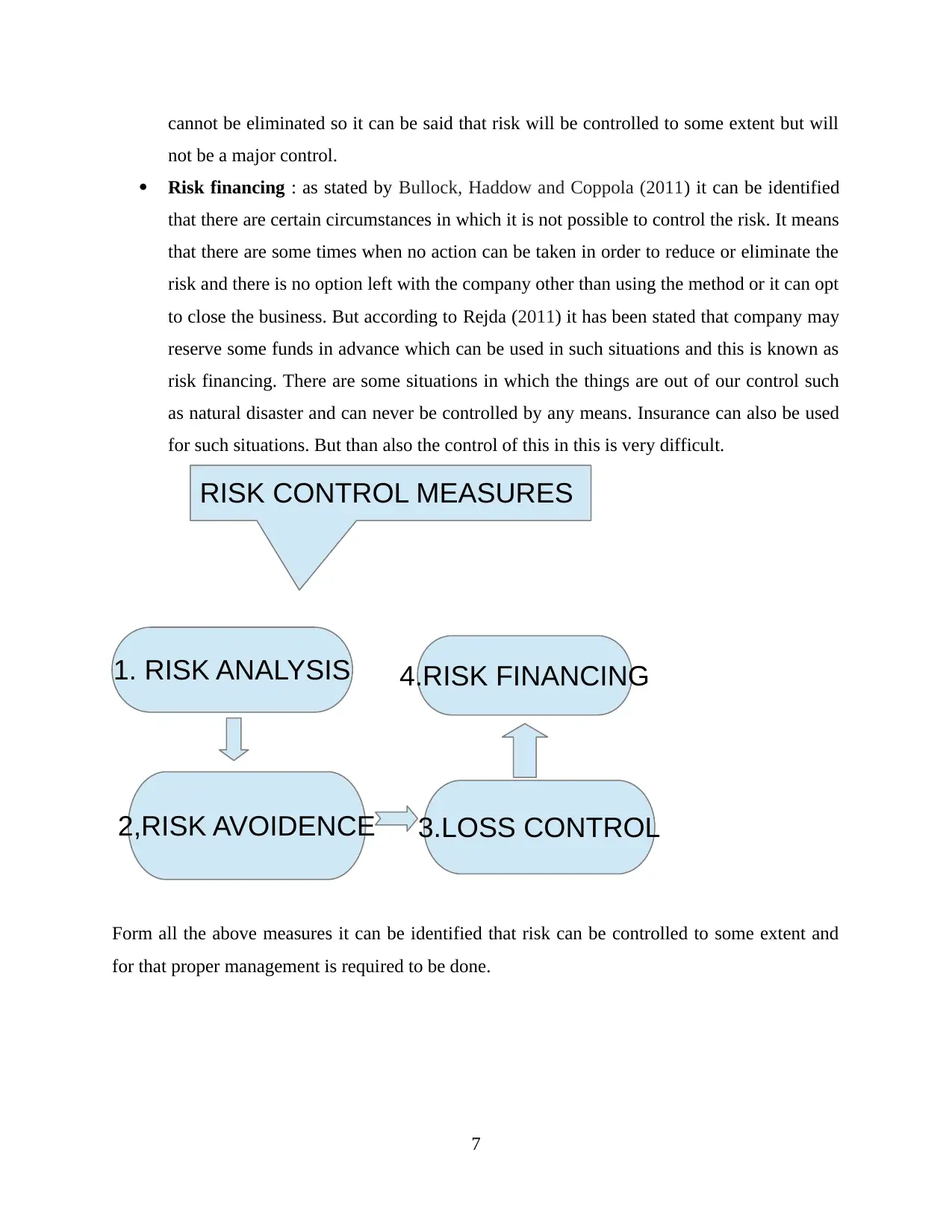
cannot be eliminated so it can be said that risk will be controlled to some extent but will
not be a major control.
Risk financing : as stated by Bullock, Haddow and Coppola (2011) it can be identified
that there are certain circumstances in which it is not possible to control the risk. It means
that there are some times when no action can be taken in order to reduce or eliminate the
risk and there is no option left with the company other than using the method or it can opt
to close the business. But according to Rejda (2011) it has been stated that company may
reserve some funds in advance which can be used in such situations and this is known as
risk financing. There are some situations in which the things are out of our control such
as natural disaster and can never be controlled by any means. Insurance can also be used
for such situations. But than also the control of this in this is very difficult.
Form all the above measures it can be identified that risk can be controlled to some extent and
for that proper management is required to be done.
7
1. RISK ANALYSIS
2,RISK AVOIDENCE 3.LOSS CONTROL
4.RISK FINANCING
RISK CONTROL MEASURES
not be a major control.
Risk financing : as stated by Bullock, Haddow and Coppola (2011) it can be identified
that there are certain circumstances in which it is not possible to control the risk. It means
that there are some times when no action can be taken in order to reduce or eliminate the
risk and there is no option left with the company other than using the method or it can opt
to close the business. But according to Rejda (2011) it has been stated that company may
reserve some funds in advance which can be used in such situations and this is known as
risk financing. There are some situations in which the things are out of our control such
as natural disaster and can never be controlled by any means. Insurance can also be used
for such situations. But than also the control of this in this is very difficult.
Form all the above measures it can be identified that risk can be controlled to some extent and
for that proper management is required to be done.
7
1. RISK ANALYSIS
2,RISK AVOIDENCE 3.LOSS CONTROL
4.RISK FINANCING
RISK CONTROL MEASURES
Paraphrase This Document
Need a fresh take? Get an instant paraphrase of this document with our AI Paraphraser
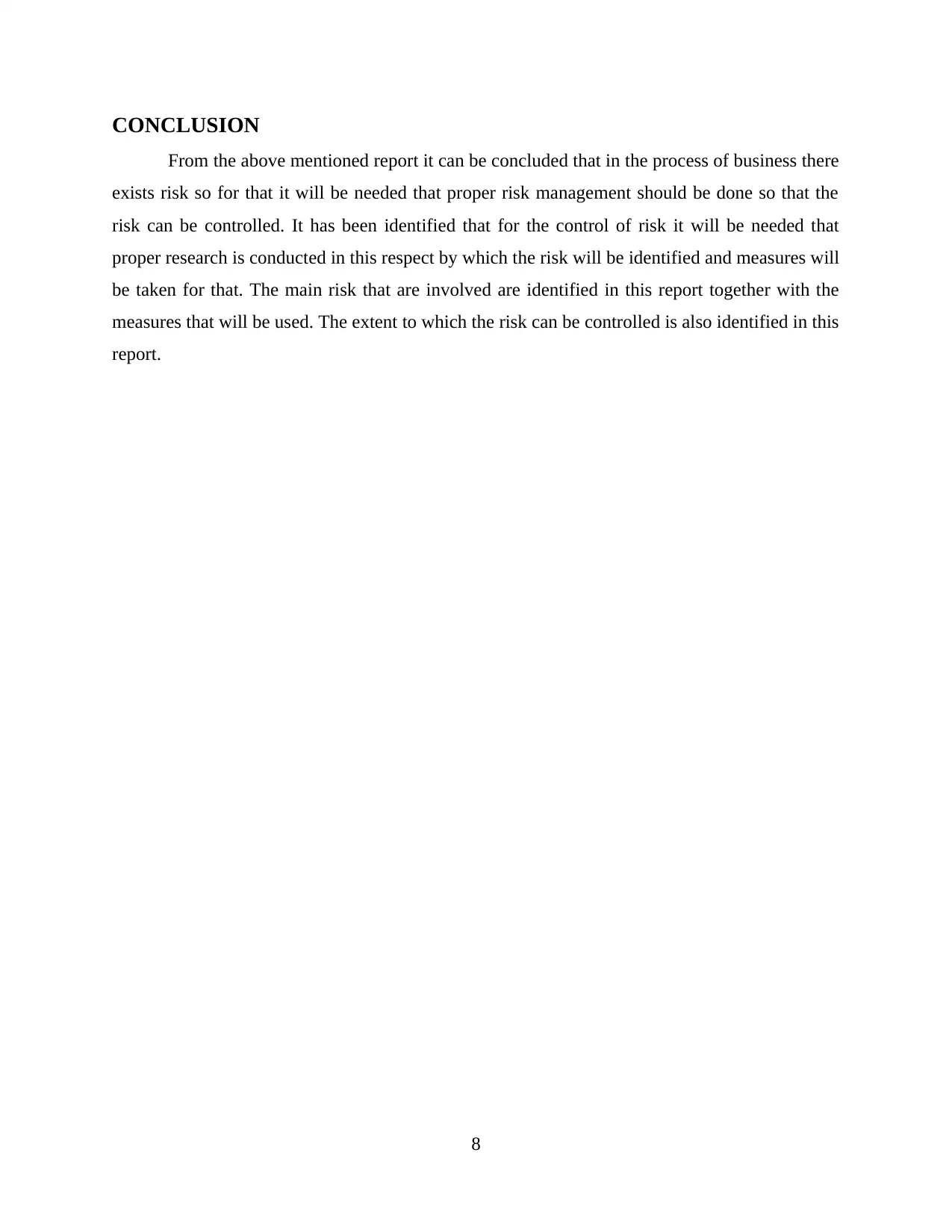
CONCLUSION
From the above mentioned report it can be concluded that in the process of business there
exists risk so for that it will be needed that proper risk management should be done so that the
risk can be controlled. It has been identified that for the control of risk it will be needed that
proper research is conducted in this respect by which the risk will be identified and measures will
be taken for that. The main risk that are involved are identified in this report together with the
measures that will be used. The extent to which the risk can be controlled is also identified in this
report.
8
From the above mentioned report it can be concluded that in the process of business there
exists risk so for that it will be needed that proper risk management should be done so that the
risk can be controlled. It has been identified that for the control of risk it will be needed that
proper research is conducted in this respect by which the risk will be identified and measures will
be taken for that. The main risk that are involved are identified in this report together with the
measures that will be used. The extent to which the risk can be controlled is also identified in this
report.
8
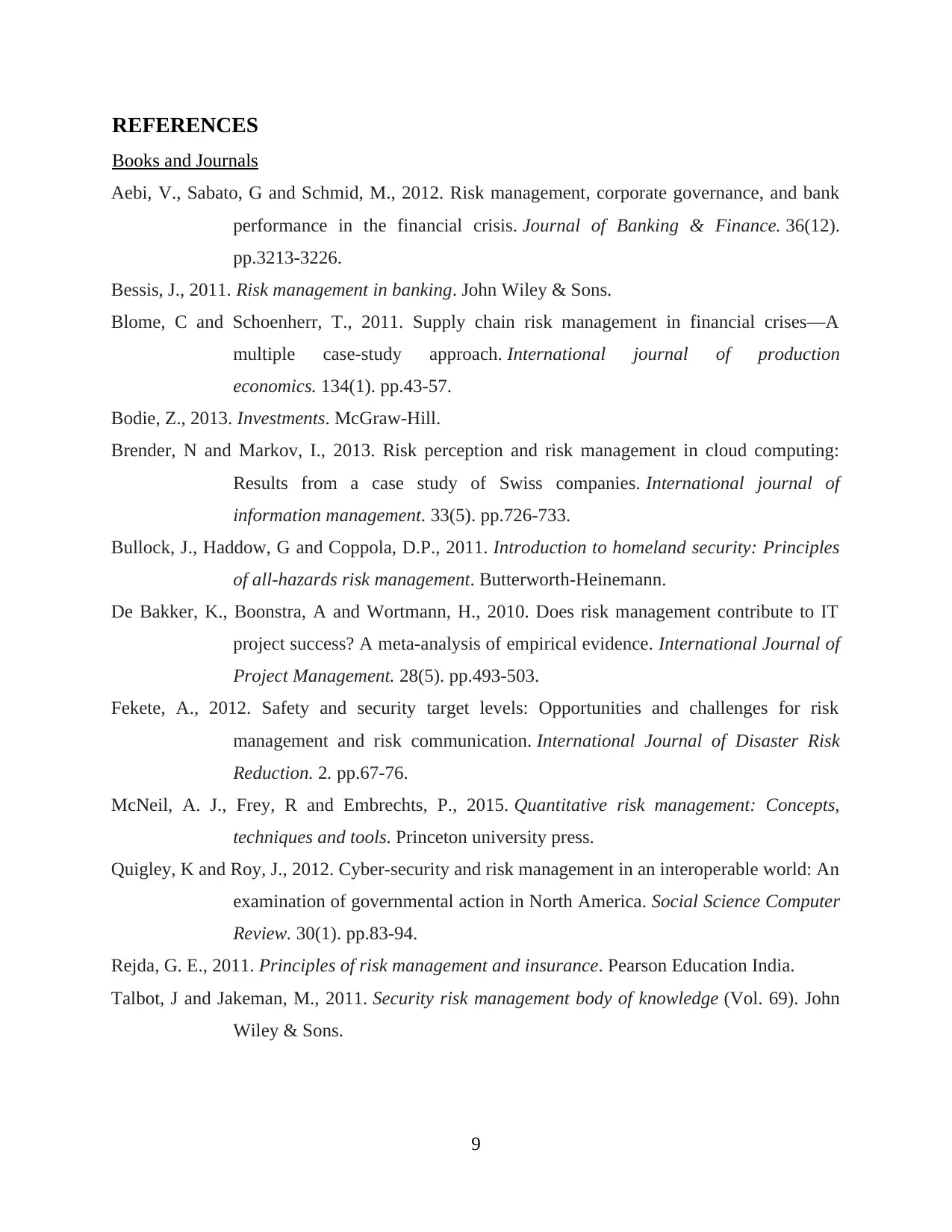
REFERENCES
Books and Journals
Aebi, V., Sabato, G and Schmid, M., 2012. Risk management, corporate governance, and bank
performance in the financial crisis. Journal of Banking & Finance. 36(12).
pp.3213-3226.
Bessis, J., 2011. Risk management in banking. John Wiley & Sons.
Blome, C and Schoenherr, T., 2011. Supply chain risk management in financial crises—A
multiple case-study approach. International journal of production
economics. 134(1). pp.43-57.
Bodie, Z., 2013. Investments. McGraw-Hill.
Brender, N and Markov, I., 2013. Risk perception and risk management in cloud computing:
Results from a case study of Swiss companies. International journal of
information management. 33(5). pp.726-733.
Bullock, J., Haddow, G and Coppola, D.P., 2011. Introduction to homeland security: Principles
of all-hazards risk management. Butterworth-Heinemann.
De Bakker, K., Boonstra, A and Wortmann, H., 2010. Does risk management contribute to IT
project success? A meta-analysis of empirical evidence. International Journal of
Project Management. 28(5). pp.493-503.
Fekete, A., 2012. Safety and security target levels: Opportunities and challenges for risk
management and risk communication. International Journal of Disaster Risk
Reduction. 2. pp.67-76.
McNeil, A. J., Frey, R and Embrechts, P., 2015. Quantitative risk management: Concepts,
techniques and tools. Princeton university press.
Quigley, K and Roy, J., 2012. Cyber-security and risk management in an interoperable world: An
examination of governmental action in North America. Social Science Computer
Review. 30(1). pp.83-94.
Rejda, G. E., 2011. Principles of risk management and insurance. Pearson Education India.
Talbot, J and Jakeman, M., 2011. Security risk management body of knowledge (Vol. 69). John
Wiley & Sons.
9
Books and Journals
Aebi, V., Sabato, G and Schmid, M., 2012. Risk management, corporate governance, and bank
performance in the financial crisis. Journal of Banking & Finance. 36(12).
pp.3213-3226.
Bessis, J., 2011. Risk management in banking. John Wiley & Sons.
Blome, C and Schoenherr, T., 2011. Supply chain risk management in financial crises—A
multiple case-study approach. International journal of production
economics. 134(1). pp.43-57.
Bodie, Z., 2013. Investments. McGraw-Hill.
Brender, N and Markov, I., 2013. Risk perception and risk management in cloud computing:
Results from a case study of Swiss companies. International journal of
information management. 33(5). pp.726-733.
Bullock, J., Haddow, G and Coppola, D.P., 2011. Introduction to homeland security: Principles
of all-hazards risk management. Butterworth-Heinemann.
De Bakker, K., Boonstra, A and Wortmann, H., 2010. Does risk management contribute to IT
project success? A meta-analysis of empirical evidence. International Journal of
Project Management. 28(5). pp.493-503.
Fekete, A., 2012. Safety and security target levels: Opportunities and challenges for risk
management and risk communication. International Journal of Disaster Risk
Reduction. 2. pp.67-76.
McNeil, A. J., Frey, R and Embrechts, P., 2015. Quantitative risk management: Concepts,
techniques and tools. Princeton university press.
Quigley, K and Roy, J., 2012. Cyber-security and risk management in an interoperable world: An
examination of governmental action in North America. Social Science Computer
Review. 30(1). pp.83-94.
Rejda, G. E., 2011. Principles of risk management and insurance. Pearson Education India.
Talbot, J and Jakeman, M., 2011. Security risk management body of knowledge (Vol. 69). John
Wiley & Sons.
9
⊘ This is a preview!⊘
Do you want full access?
Subscribe today to unlock all pages.

Trusted by 1+ million students worldwide
1 out of 13
Related Documents
Your All-in-One AI-Powered Toolkit for Academic Success.
+13062052269
info@desklib.com
Available 24*7 on WhatsApp / Email
![[object Object]](/_next/static/media/star-bottom.7253800d.svg)
Unlock your academic potential
Copyright © 2020–2025 A2Z Services. All Rights Reserved. Developed and managed by ZUCOL.





